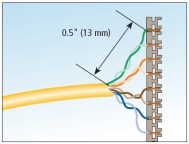You can invest in the best cable and hardware, but if they’re not installed properly, they won’t work, or at least they won’t work well. Protect your investment and follow these installation guidelines.
 1. Cable pair twists. This is the most important guideline you can follow for twisted-pair cable. The pair twists are responsible for much of cable’s performance. If you lose the twists, you lose performance.
1. Cable pair twists. This is the most important guideline you can follow for twisted-pair cable. The pair twists are responsible for much of cable’s performance. If you lose the twists, you lose performance.
When terminating CAT5e or higher, maintain pair twists to within 13 mm (0.5 in.) from the point of termination. And remove as little of the sheath as possible.
When terminating cable, only strip back the cable sheath 1″. Keep pair untwists to a maximum of 0.5″.
 2. Bend radius. If you bend twisted-pair cable too much, you loosen the twists, and yes, lose performance. The following bend radii are under no-load conditions:
2. Bend radius. If you bend twisted-pair cable too much, you loosen the twists, and yes, lose performance. The following bend radii are under no-load conditions:
- UTP horizontal: 4 times the cable diameter.
- Sc/UTP horizontal: 8 times the cable diameter.
- Multipair backbone: 10 times the cable diameter.
3. Tension. To avoid stretching, pulling tension should not exceed 110 N (25 lb./ft. or 110N). Pulling too hard untwists the pairs, which can cause transmission problems, and can affect cable certification. Use supports and trays in cable runs to minimize sagging, which pulls on the pairs and degrades performance.
 4. Cinching. Take care not to cinch cable bundles tightly, which causes stress and degrades performance. Tie cable bundles loosely. And never staple cables.
4. Cinching. Take care not to cinch cable bundles tightly, which causes stress and degrades performance. Tie cable bundles loosely. And never staple cables.
5. Connecting hardware. Use connecting hardware of the same category or higher. The transmission of your components will always be the lowest category in the link. So, if you’re using CAT6 cable, use CAT6 connectors.
6. Miscellaneous considerations. Visually inspect the cable for proper terminations, bend radius, tension, nicks, etc. Don’t uncoil UTP cable on a spool. It can cause kinks. Rotate the spool instead. Plan for 12 inches of slack cable behind wall outlets for possible future reterminations.
7. T568A, T568B, and USOC wiring
There are two approved pinning methods in the TIA-568-C standard for terminating network cable to 8-position RJ-45 jacks and connectors: T568A and T568B. The difference between the two is the pin position of the orange and green pairs.
The T568B wiring scheme is the de facto standard for communications networking in the U.S. It is the same as AT&T’s old 258A color scheme. T568B offers backward compatibility with USOC through one pair. T568A is backward compatible with both one- and two-pair USOC connections.
Whichever pinning scheme you choose to use, stick with it. T568A and T568B pinnings are not interchangeable. Mixing the two can cause crossed pairs, which just don’t work.
8. Straight-pinned and crossover cable
Straight-pinned cable has the most common type of pinning. The send and receive pairs are wired straight through on either end of the cable.
Crossover cable is generally used for peer-to-peer connections. The send and receive pairs are crossed between Connector A to Connector B on either end of the cable.
Filed under: IT Infrastructure | Tagged: copper cable, copper cable installation, copper guidelines, T568A, T568B, USOC |






[…] the data center to the IDF at the front-line cash registers. The upgrade includes installing new horizontal CATx cable, patch cables, patch panels, and secure wallmount […]